NVIDIA's GeForce GT 430: The Next HTPC King?
by Ryan Smith & Ganesh T S on October 11, 2010 9:00 AM ESTPower, Temperature, & Noise
We only have 1 GT 430 card on hand, so unlike past articles we cannot compile any data on the load voltages of this line of cards. Our lone Asus card has a load voltage of 1.08v, and an idle voltage of 0.88v. Idle clocks are 50.6MHz for the core, and 270MHz effective for the memory.
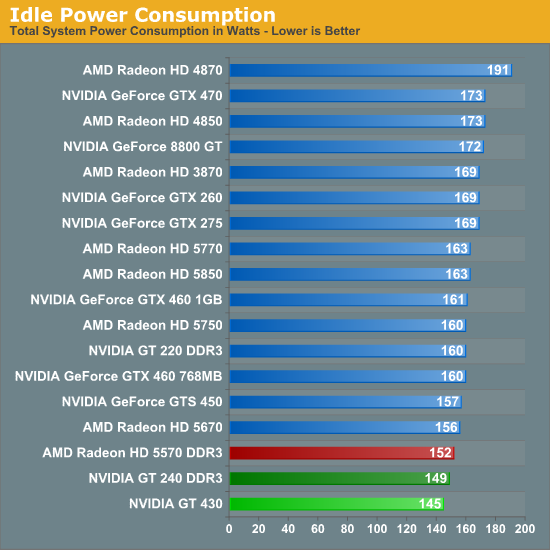
While GT 430 may not be competitive on a performance-per-dollar basis, it’s hard to argue with these power results. Even at these low wattages where our 1200W power supply isn’t very efficient, the GT 430 still delivers an idle power consumption level 7W under the Radeon 5570, and an even larger 11W advantage over the otherwise performance-superior Radeon 5670. We can’t measure the card’s actual power consumption and NVIDIA does not provide a reference level, but the GT 430 can’t be drawing more than a couple of watts here.

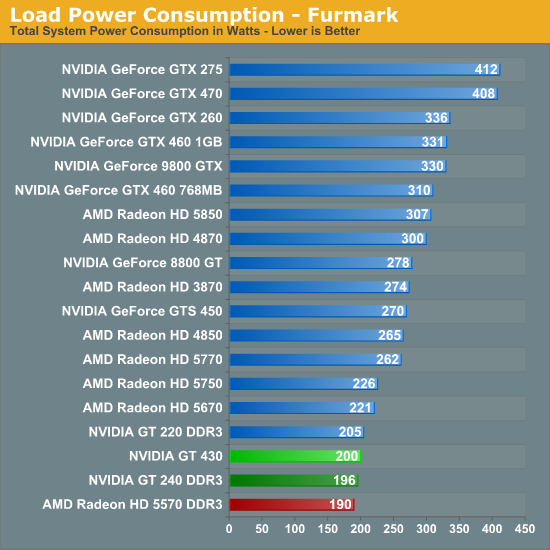
Under load things are less rosy for the GT 430. Under Crysis it ends up drawing 10W over the 5570, which serves as yet another testament to the amazing level of performance-per-watt that AMD has been able to attain; remember that the 5570 had better performance at the same time. Under Furmark the situation is just as bad, but at this point we’re looking at a more pathological case. Overall 10W isn’t going to break the bank in an HTPC (especially since these cards would rarely get up to full clocks in the first place) but it’s something to consider if every watt is going to count.

When it comes to idle temperatures, the GT 430 is second to none. With the card only consuming a couple of watts at idle in the first place, its idle temperatures are barely above room temperature (and even closer to ambient case temperatures). It’s tied with the GTS 450, which impressed us last month with its highly capable cooler. Meanwhile our 5570, which is a low-profile card just like the GT 430, ends up being a good 10C higher. AMD’s higher idle power consumption directly translates to a higher idle temperature.
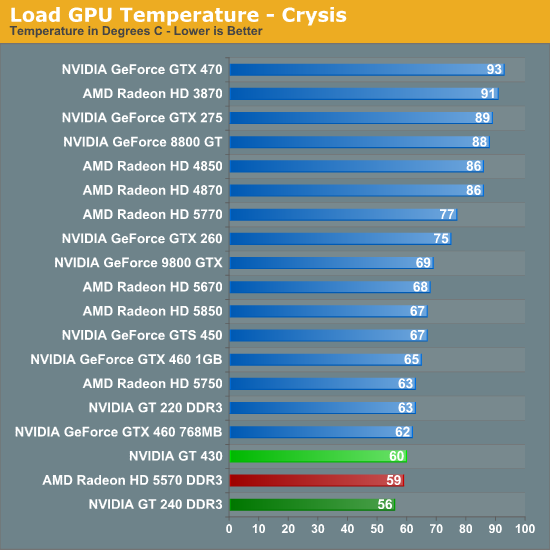
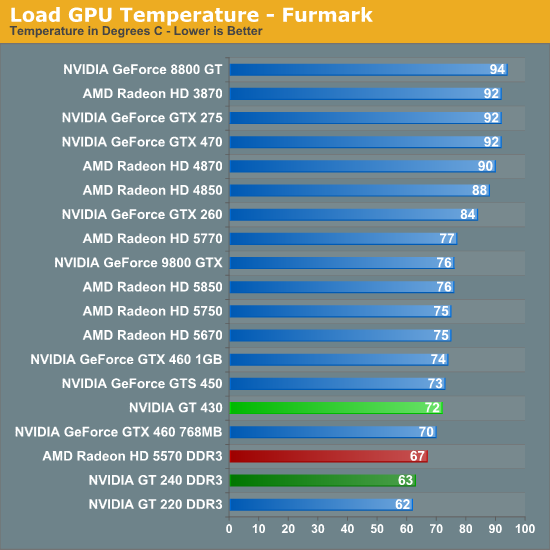
Looking at load temperatures, these results aren’t all that surprising given the cooler in use. The Asus cooler is practically a passive cooler, as the small fan is not capable of moving much air (though it is unusual to not see Asus aggressive on cooling). As a result it manages to reach higher temperatures, but we’re still only talking about 60C under Crysis and 72C under Furmark. This is worse than the 5570 and its larger fan by a bit, but not significantly so.
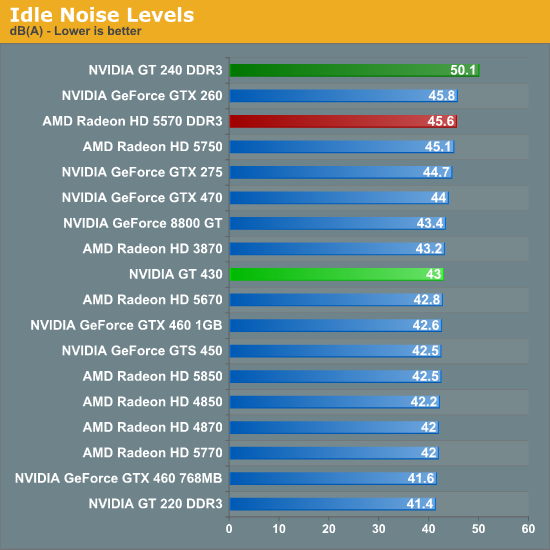
At idle the GT 430 is consistent with our other cards. With the exception of a couple ridiculous cards like our GT 240 and in this case the 5570, everything is at roughly 42-44dB(A). The 5570 is more fan than heatsink, which is likely why it has such a poor showing here compared to the GT 430.
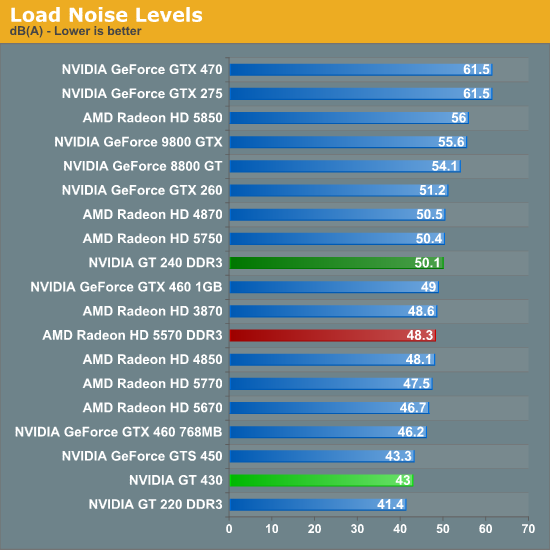
The payoff of accepting higher temperatures is less noise to contend with. The GT 430 never needs to ramp up its fan in our tests, delivering a load noise level even lower than the GTS 450, and only worse than a GT 220 that runs up against ambient noise levels. If you want to make a good HTPC card then it needs to be silent, and Asus/NVIDIA have delivered on that here. It’s not quite silent since it’s not passive, but it’s about as close as one can reasonably achieve. It’s also noticeably better than the 5570, a card which is by no means noisy. If noise is a primary concern then the GT 430 is a very good candidate for a HTPC.










120 Comments
View All Comments
n9ntje - Monday, October 11, 2010 - link
Sad to see Nvidia doesn't live up to expectations, while they want us to believe that they have a perfect HTPC card, it isn't.To most people, image quality counts. 3D is still a niche.
IceDread - Monday, October 11, 2010 - link
Yeap, it's always best if the competition is even, gives us the best prices.medi01 - Monday, October 11, 2010 - link
I am afraid market is too slow to react to nVidia having worse products, AMD has nowhere near market share that it deserves to have.We can't expect one player to dominate all the time. So when the underdog creates superior products, it should benefit from it. But this is not the case in GPU market, unfortunatelly, as nVidia still keeps much bigger market share, than AMD.
dnd728 - Monday, October 11, 2010 - link
I've tried quite a few ATI/AMD cards over the years, including the latest 5000 series, and to date not a single one of them worked right, i.e. without keep crashing Windows.It could be one reason.
electroju - Monday, October 11, 2010 - link
I agree and I have also used ATI and AMD graphics over the years. AMD graphics writes the worst software or drivers from a reputable company. I go with nVidia because I care for reliability and stability. I do not mind spending money on nVidia graphics because the money goes towards software development. The cost of AMD graphics is too low to provide enough for software development.Zoomer - Monday, October 11, 2010 - link
I have personally found nvidia cards to have inferior hardware quality. This was very evident from the time when quality dacs for vga mattered, and nvidia cards absolutely sucked at that. Further suboptimal decisions made their cards meh.Software wise, I thought nvidia's software quality peaked around the time of the detonators.
AmdInside - Monday, October 11, 2010 - link
DACs depended on the maker of the card. Quadro NVS cards which were made by NVIDIA were regarding as having excellent 2D image quality over analog display. Sadly a lot of NVIDIA partners used cheap DACs on some of their cards.mentatstrategy - Wednesday, October 13, 2010 - link
Nvidia Fanboi: I have used ati cards and they suck!ATI Fanboi: I have used nvidia cards and they suck!
heflys - Monday, October 11, 2010 - link
Hmmm....Haven't had a problem with ATi/AMD drivers thus far.duploxxx - Friday, October 15, 2010 - link
perhaps you need to read a bit more and see how many 1000's have been recently been affected by this awesome nvidia reliability and stability when they all had to throw away there graphic cards and laptops.